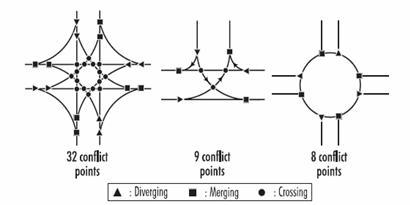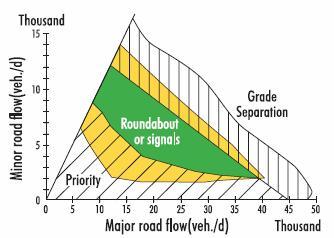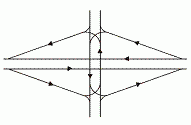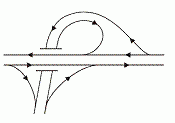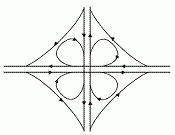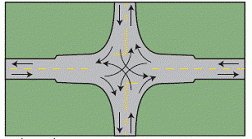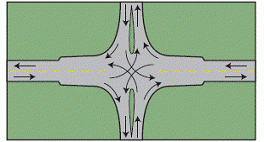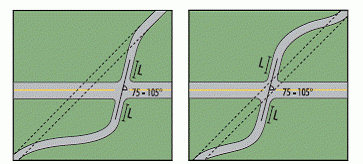Junctions
Junctions
Junctions, at-grade or grade separated, are locations of high accident concentration. In most countries 40 - 60% of the total number of accidents occurs at junctions. Consequently, special attention should be given in determining the type, the shape of junctions, as well as the number of junctions along a road axis and the efficient design of each one.
Road safety criteria in junctions design
The main objective of junction design is to increase convenience, comfort and safety while at the same time enhancing the efficient movement of all road users (motor vehicles, buses, trucks, bicycles, and pedestrians) [28].
Junctions are intended to operate where vehicles often must share space with other vehicles and pedestrians. Negotiating a junction requires many simultaneous or closely spaced decisions, such as selection of the proper lane; manoeuvring to get into the proper position; need to decelerate, stop, or accelerate; and need to select a safe gap. The following basic areas should be reviewed in conjunction with these decisions to produce a satisfactory design: junction angle; coordination of the vertical profiles of the intersecting roads; coordination of horizontal and vertical alignment for junctions on curves; improvement of operation, safety, and capacity through channelization; and drainage requirements for safe operation. Not only must the horizontal layout be carefully thought out, but the coordination of the vertical and horizontal alignment should be given more emphasis. Poor integration of these two elements often results in a junction that is less safe and uncomfortable to use [100].
An important safety aim is to match the speed at which drivers negotiate the junction with the complexity of the decisions to be made. This can be done, for example, by only allowing simple merging manoeuvres on high speed roads or by ensuring that drivers reduce speed on the junction approach (e.g. by deflection of path through a roundabout). Sight lines should provide drivers with sufficient information to make safe decisions, but not tempt them to try to select short gaps in conflicting traffic flows.
More specifically, the main design principles for junctions include:
- Minimization of traffic conflicts locations: A junction has a set of conflict points between vehicle paths, and a good design should aim at minimizing the severity of potential accidents at these points.
Figure 8 Number of conflict points at junctions and roundabouts
- Sufficient sight distances: Appropriate sight distances, both while approaching the junction area and being at the junction are of major importance for the safe operation of the junction. The creation of junctions in vertical sag curves is considered to be favourable. Another important parameter concerns the prompt perception and comprehension of the junction's layout and operation by drivers, particularly those who are not regular users of the junction, and therefore the selection of appropriate path and travel speed, on which drivers can be assisted by improved horizontal and vertical road marking and appropriate junction layout [49].
- Longitudinal section and transverse gradients design: It is important to design the longitudinal section of the road in the junction area and access areas, in order to achieve a smooth transition of transverse gradients and effective drainage. Ideal location for a junction is on a tangent. Location in curves may cause problems, as visibility is reduced, conflict points increase and superelevation and lane widening make the situation more complicated. Moreover, junctions should not have gradients over 3%, and never more than 6% in order to provide both improved comfort and sight distances; junctions should also preferably not be located at or near crest vertical curves [70]
- Left turning movements: The locations where left turns and U-turns are allowed should be specifically determined and appropriately configured, by means of traffic islands and/or marked lanes. It should be noted that left turns are high risk movements on a level junction. Research results in Great Britain have shown that these movements (right turns in Great Britain) are responsible for around 70% of all accidents on three-arm junctions [89]
- Minimization of weaving areas
Effect of junction type on road safety
The choice of a junction design depends upon several factors, whose relative importance varies between cases and should be assessed. The most important ones are [70]:
- Traffic safety
- Road type and function
- Number of concurring legs
- Traffic volume and type
- Design and operating speed
- Priority setting
- Terrain
- Available room
- Adjacent land use
- Service to neighbouring population
- Network considerations (design consistency)
- Environmental concerns
- Cost
The type of junction has to be suited to the road type, the environment and capacity, in order to maintain good readability both of the road and of the junction, as well as a satisfactory level of safety. According to the above, for example, junctions or roundabouts should not be used on motorways, and signalized junctions need not to be used on rural roads, except in very special cases. The following Figure 8 shows guidelines for the selection of junction type according to traffic flows.
Figure 9 Type of junction based on traffic flows (IHT 1997)
More specifically, the various types of junction present different advantages and limitations:
- Three- or four-arm non-signalized at grade junctions: These junctions may provide satisfactory road safety level when operating in low traffic volumes and speeds. Traffic islands and pavement marking, delimiting traffic directions and creating special lanes for left turning movements have a positive road safety effect [59]. When traffic volumes increase, it is necessary to establish traffic signals or consider modifications of the junction layout. In urban areas, changing a three- or four-arm level junction into a roundabout may lead to around 30% accidents reduction [91].
- Roundabouts. Roundabouts have higher capacity than three- or four-arm non-signalized junctions; Roundabouts appear to have considerable safety advantages over other types of at-grade junction and are now being widely used in many countries [63]. However, in some countries they appear to be related to higher accident involvement of motorized two-wheelers and bicycles [92].
Converting junctions to roundabouts can improve safety and traffic flow. Roundabouts can contribute to road safety in the following ways [19]:
- Conflict points between the traffic streams are theoretically reduced
- Roads users entering the roundabout have to yield to road users already in the roundabout, thus they are forced to observe traffic at the roundabout more carefully
- All traffic comes from one direction
- Left turns are eliminated
- Speeds are reduced, as drivers have to drive around a traffic island located in the middle of a junction
Roundabouts reduce the number of injury accidents depending on the number of arms and the previous form of traffic control. There appears to be a larger effect in junctions that used to have yield control than in junctions that used to be traffic controlled. Fatal accidents and serious injury accidents are reduced more than slight injury accidents [19]:
- Signalized junctions. Signalized level junctions are the most common junction type in urban areas. Fatal accidents at signalized junctions are predominantly multivehicle [4]. The majority of accidents on signalized junctions concern left-turn vehicle movement or pedestrian's movement. Moreover, a higher accident involvement, in relation to their traffic volumes, may be observed for motorized two-wheelers and bicycles [92].
- Grade separated junctions (interchanges). These junctions present lower accident rates in general compared to at-grade junctions. It is noted that upgrading a three-arm non-signalized junction to a grade separated junction may result in a 50% accidents reduction, while the respective percentage for a four-arm junction may reach 75%.[89]. However, for the safe operation of a grade separated junction, an efficient planning is required. For example, research results have shown that reducing the number of lanes in the junction area, or designing weaving length of less than 1 km, may have negative safety impact. Moreover, accident rates on the arms of the grade separated junctions are about higher compared to the sections outside junction. Additionally, accident severity rates on junction arms are higher compared to the related rates for interurban roads (not characterized as motorways) [87].
There are different forms of grade separated junctions (interchanges). In full grade-separated interchanges, with separate lanes for all streams of traffic, all movements which require crossing other streams of traffic are removed and reduced to changing traffic lanes. Various forms of interchanges have been developed, such as diamond interchanges, trumpet interchanges and full or partial cloverleaf interchanges. Diamond interchanges (simple and comprehensive, with straight ramps, and with minor roads running above the main road) appear to be the safest form of interchange.
Diamond, trumpet and cloverleaf
The effect on traffic safety from replacing a level junction with a grade-separated (interchange) has not been fully determined. If accidents on crossroad arms of a length corresponding to the length of the ramps in interchanges are included in accident figures, then interchanges are safer than both three- and four-arm junctions. However, ramps constitute a new road element in interchanges, and therefore accidents on stretches of road of equivalent ramp length at junctions should not be included in accident figures for junctions.
Effectiveness of junction treatment
Channelization
- Channelization at junctions is intended to:
- Segregate traffic flows from each other and reduce the area of conflict between different intersecting traffic streams
- Provide junction angles to give good visibility
- Define driving patterns and indicate which road has priority at a junction
It can be carried out by using traffic islands (physical channelization or road markings (painted channelization) and can include:
- Minor road channelization
- Left-turn lanes
- Passing lanes
- Full channelization
Unchannelized crossroad and Channelized crossroad
The majority of the various forms of channelization appear to have a more favourable effect on the number of accidents at crossroads than at t-junctions. There is a weak tendency that the more comprehensive the channelization methods are, the more favourable the effect on accidents.
Redesigning junctions
Redesigning junctions includes:
- Change to the angle between roads
- Changes to the gradients of roads approaching the junction
- Other measures to improve sight conditions at junctions
Examples of junction re-alignment
Research results are very uncertain, however it can be deduced that an angle of less than 90 degrees gives the fewest injury accidents and the opposite appears to be the case for property damage only accidents. Moreover, a change in gradient on approaches to an junction from more than 3% to less than 3% appear to reduce the number of injury accidents, but increase the number of damage only accidents. The effect of increasing sight triangles at junctions was not found to be statistically significant in a number of studies.
Staggered junctions
Research results show that four-arm junctions have higher accident rates than three-arm junctions, because they have more conflict points between the streams of traffic. Staggered junctions aim at reducing the number of conflict points at junctions and can be constructed in two ways: left-right staggering and right-left staggering.
Left - right staggering and Right - left staggering
The effect of staggered junctions depends on the proportion of minor road traffic at the crossroads before staggering. When minor road traffic is low, no safety gains are obtained by dividing the crossroads into a staggered junction. When minor road traffic is heavy, the number of injury accidents may be significantly reduced.

